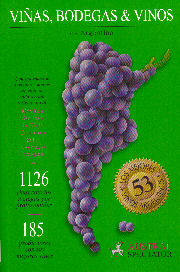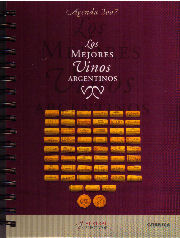Primafila, Janio, Sauvignon Blancs
January 2007, page 51
Argentina for beginners
Summer is definitely upon us. For some, there’s the siren call of a dining room that’s aire acondicionado. For others, it’s a chance to catch some rays and bronze a little while dining al fresco, or enjoy the cooling evening breezes as the heat of the day fades away. Buenos Aires abounds with places where you can grab a seat at a sidewalk or plaza table, ranging from mass gathering places like Plaza Dorrego in San Telmo and Plaza Serrano in Palermo SoHo to side-by-side restaurant rows with outdoor tables, like Village Recoleta, Puerto Madero, or Plaza Costa Rica. With limited regulation on where you can stick a table, even the average neighborhood café is likely to have a table or two strategically placed out on the sidewalk in front.

Imagine, if you will, a beautiful terrace looking out over a sculpted park. Comfortable cushioned lounge chairs around low tables are scattered across the flagstones. The seats are taken up by a mix of the young and beautiful, the wealthy and famous, the curious, and, simply, the hungry. Primafila, officially at Pueyrredón 2501, but in practice located in the center of the second level terrace of the Buenos Aires Design Center, 4804-0055, is a spot to see and be seen, and to dine truly well. While you can have your meal inside, the place to be is afuera, where you’ll be greeted and taken care of by a cadre of informed, capable staff, who really know something about the food and wine they are serving. The focus is on creative Italian cuisine, with a few Argentine twists. They offer some don’t miss pizzas, beautifully presented salads, and absolutely delicious pastas and main courses. If you’re into the whole world of offal, their spiced and caramelized sweetbreads are quite possibly the finest presentation of this organ meat I’ve ever had the pleasure to try in a restaurant. The restaurant offers one of the better wine lists in the area, and it’s not over-priced. Overall, Primafila is a bit on the expensive side, but not at all out of line for the setting and quality of the food.

One of the prettiest little plazas for dining al fresco is Plaza Costa Rica, located in the heart of Palermo. Surrounding the park are a good number of restaurants and cafes, all of the more casual variety, and many of them serving up some excellent food. One of our favorites is a self-termed lugar de encuentro, or meeting place – a trendy corner Argentine style bistro called Janio, at Malabia 1805, 4833-6540, www.janiorestaurant.com.ar. The outdoor area that surrounds the restaurant is one of the prime people watching spots of the neighborhood, whether it’s people walking by, or your fellow diners, or for that matter, the waiters and waitresses, who are both reasonably versed in the restaurant’s food, and some of the prettiest eye candy in the zone. The food tends towards the light side, with a mix of interesting pastas, vegetarian dishes, and lighter twists on classic porteño fare. It would be a shame to pass up their house-made paté, or their over-sized eggplant and tomato ravioli, or for that matter, one of the better veggie-burgers in the city. That’s not to say that you shouldn’t try their meat dishes – they handle those equally well. Their wine list and beer selection is pretty basic and inexpensive, but they also have a well stocked bar and bartenders who know how to mix a drink. On the whole, Janio is a great value, and you certainly won’t be stretching your budget while still having a delightful meal.
 The summer is a time when I like an absolutely cold, crisp bottle of white wine, kept on ice right there by my side. A favorite for drinking in hot weather is Sauvignon blanc. It’s hard to find a truly lean and dry styled Sauvignon here, as the preferred style tends to be a bit “fatter” and often having spent a bit of time in an oak barrel.
The summer is a time when I like an absolutely cold, crisp bottle of white wine, kept on ice right there by my side. A favorite for drinking in hot weather is Sauvignon blanc. It’s hard to find a truly lean and dry styled Sauvignon here, as the preferred style tends to be a bit “fatter” and often having spent a bit of time in an oak barrel.  But recently I’ve come across two truly delicious offerings of the former style – which not only is great for the season, but pairs beautifully with food. Both wines range in the low 20 pesos retail, probably running around 30 in a restaurant – and are steals at that price. The first, and my favorite of the two by a slight edge is the La Flor de Pulenta Sauvignon Blanc 2006 – crisp and dry, with delightful lime and grass aromas, amazingly juicy acidity, and a long finish – truly it reminds me of a high quality Sancerre from the Loire Valley. The other is the Los Cardos Sauvignon Blanc 2006 from Doña Paula, with a slightly more tropical fruit style, but still with lean acidity and great length – in some ways this version called to mind a classic New Zealand Sauvignon.
But recently I’ve come across two truly delicious offerings of the former style – which not only is great for the season, but pairs beautifully with food. Both wines range in the low 20 pesos retail, probably running around 30 in a restaurant – and are steals at that price. The first, and my favorite of the two by a slight edge is the La Flor de Pulenta Sauvignon Blanc 2006 – crisp and dry, with delightful lime and grass aromas, amazingly juicy acidity, and a long finish – truly it reminds me of a high quality Sancerre from the Loire Valley. The other is the Los Cardos Sauvignon Blanc 2006 from Doña Paula, with a slightly more tropical fruit style, but still with lean acidity and great length – in some ways this version called to mind a classic New Zealand Sauvignon.
January and February, while they’re the height of the tourist season, are also the height of the summer. That means that a lot of locals take off for points like the shore, the south of the country, or neighboring vacation destinations like Uruguay, Brazil, and Chile. While I always recommend making a reservation for dining out, especially at dinner time, in Buenos Aires, I make that an extra strong recommendation during this season, as many restaurants simply close up for anywhere from two to four weeks for a summer vacation. If you’re headed here and there’s somewhere you simply must dine at, it’s worth your while to find out if they’ll be here while you are!
In October 2006, I started writing for this Spanish language magazine, covering their English language section for travellers. I wrote for them for about two years. The copy editor, apparently not fluent in English, used to put each paragraph in its own text box on a two column page, in what often seemed to be random order, making the thread of the column difficult to follow. I’ve restored the paragraphs to their original order.
















